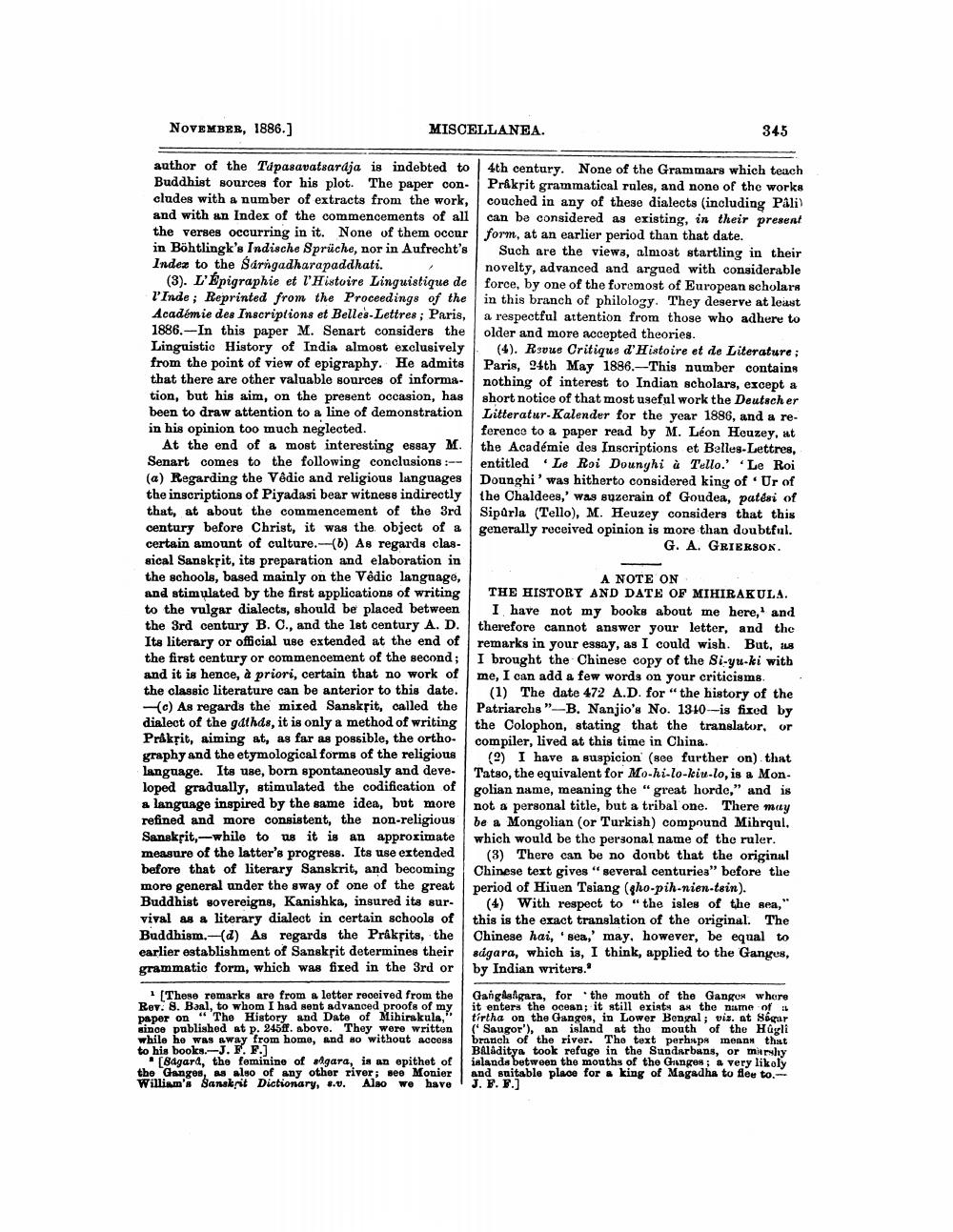________________
NOVEMBER, 1886.]
MISCELLANEA.
345
author of the Tapasavatsardja is indebted to 4th century. None of the Grammars which teach Buddhist sources for his plot. The paper con. Prakrit grammatical rules, and nono of the works cludes with a number of extracts from the work, couched in any of these dialects (including Pali and with an Index of the commencements of all can be considered as existing, in their present the verses occurring in it. None of them occur form, at an earlier period than that date. in Böhtlingk's Indische Sprüche, nor in Aufrecht's Such are the view3, almoat startling in their Index to the Śdrigadharapaddhati.
novelty, advanced and argued with considerable (3). L'Epigraphie et l'Histoire Linguistique de force, by one of the foremost of European scholars l'Inde ; Reprinted from the Proceedings of the in this branch of philology. They deserve at least Académie des Inscriptions et Belles Lettres : Paris, a respectful attention from those who adhere to 1886.--In this paper M. Senart considers the older and more accepted theories. Linguistic History of India almost exclusively (4). Rsvue Critique d'Histoire et de Literature; from the point of view of epigraphy. He admits Paris, 94th May 1886.-This number contains that there are other valuable sources of informa- nothing of interest to Indian scholars, except a tion, but his aim, on the present occasion, has short notice of that most useful work the Deutsch er been to draw attention to a line of demonstration Litteratur. Kalender for the year 1886, and a rein his opinion too much neglected.
ference to a paper read by M. Léon Heuzey, at At the end of a most interesting essay M. the Académie des Inscriptions et Belles-Lettres, Senart comes to the following conclusions :-- entitled "Le Roi Dounghi à Tello.' 'Le Roi (a) Regarding the Vedic and religious languages Dounghi' was hitherto considered king of Ur of the inscriptions of Piyadasi bear witness indirectly the Chaldees,' was suzerain of Goudea, patési of that, at about the commencement of the 3rd Sipärla (Tello), M. Heuzey considers that this century before Christ, it was the object of a generally received opinion is more than doubtful. certain amount of culture.- ) As regards clas
G. A. GRIERSOK. sical Sanskrit, its preparation and elaboration in the schools, based mainly on the Vedio language,
A NOTE ON and stimulated by the first applications of writing THE HISTORY AND DATE OF MIHIRAKULA. to the vulgar dialects, should be placed between I have not my books about me here, and the 3rd century B. O., and the 1st century A. D. therefore cannot answer your letter, and the Its literary or official use extended at the end of remarks in your essay, as I could wish. But, as the first century or commencement of the second ; I brought the Chinese copy of the Si-yu-ki with and it is hence, à priori, certain that no work of me, I can add a few words on your criticisms. the classic literature can be anterior to this date.
(1) The date 472 A.D. for the history of the (c) As regards the mixed Sanskrit, called the Patriarchs"-B. Nanjio's No. 1310--is fixed by dialect of the gathds, it is only a method of writing the Colophon, stating that the translator, or Prakrit, aiming at, as far as possible, the ortho.
compiler, lived at this time in China graphy and the etymological forms of the religious (2) I have a suspicion (see further on) that language. Its use, born spontaneously and deve. Tatso, the equivalent for Mo-hi-lo-kiu-lo, is a Monloped gradually, stimulated the codification of
golian name, meaning the "great horde," and is a language inspired by the same idea, but more not a personal title, but a tribal one. There may refined and more consistent, the non-religious be a Mongolian (or Turkish) compound Mihrqul, Sanskrit, -while to us it is an approximate which would be the personal name of the ruler. meagure of the latter's progress. Its use extended (3) There can be no donbt that the original before that of literary Sanskrit, and becoming Chinese text gives "several centuries" before the more general under the sway of one of the great period of Hiuen Tsiang (gho-pih-nien-tsin). Buddhist sovereigns, Kanishka, insured its sur. (4) With respect to "the isles of the sea," vival as a literary dialect in certain schools of this is the exact translation of the original. The Buddhism.-(d) As regards the Prákpits, the Chinese hai, sea,' may, however, be equal to earlier establishment of Sanskṣit determines their sugara, which is, I think, applied to the Ganges, grammatio form, which was fixed in the 3rd or by Indian writers."
* These remarks are from a letter received from the Rev. 8. Baal, to whom I had sent advanced proofs of my paper on "The History and Date of Mihirakula," kinoo published at p. 245ff. above. They were writton while he was away from home, and so without access to his books.-J. F.F.)
[Bdgard, the feminine of gara, is an epithet of the Ganges, as also of any other river: Beo Monier William's Sanskrit Dictionary, 8.0. Also we have
Gangasigara, for the mouth of the Ganges where it enters the ocean; it still exists as the time of tirtha on the Ganges, in Lower Bengal; vis. at sogar (Saugor'), an island at tho mouth of the Hügli branch of the river. The text perhaps means that Baláditya took refuge in the Sundarbans, or miershy islands between the mouths of the Ganges a very likoly and suitable place for a king of Magadha to flee to.-- J. F.F.)




